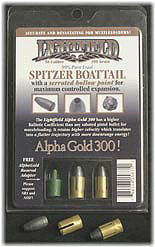|
Lightfield Alpha Gold Muzzleloading Bullets  Lightfield Ammunition has gained a very good reputation for their slug gun ammo, and now they have decided to join the muzzleloading market with their "Alpha Gold 300" lead muzzleloading bullets. What makes their bullets distinctive is the gold sabots, developed in conjunction with the world's premier muzzleloading sabot maker, MMP. At this juncture I suppose I should have acquired some sort of immunity to the outlandish, baseless claims of some manufacturers. I have not, so it appears that I never will. Sadly, I remain the poor sod that actually reads marketing materials, owner's manuals, and expects them to have some basis in fact. All too often they do not. Lightfield makes some whacky claims both in supplied materials and on their website, so allow me to get the nonsense out of the way first. Lightfield, while failing to document the ballistic coefficient of their Alpha Golds, goes on to say that they have a "higher ballistic coefficient than any saboted pistol bullet for muzzleloading." That notion is bizarre; showing ignorance of so many pistol bullets regularly used in muzzleloading today that it really does not deserve much more than a chuckle. A "feature" is the "serrated hollow points for maximum controlled expansion." Pure lead, in this case "99% pure lead" expands as a matter of course at any substantial velocity. Whether this bullet or any number of other hollow point saboted lead projectiles, you can expand a similar pancake effect with any terminal impact at good velocity. Easy expansion is what pure lead does without any great help from a serration on a hollow point. Lightfield is not alone in bogus claims, of course, as evidenced by the peculiar notion that a plastic nose added to a hollow point could possibly aid expansion, which naturally can only impede it. A hollow point helps expansion by hydraulic action; adding plastic media to a hollow point blocks the hydraulic pressure transfer to the bullet substrate. This makes the hydraulic action less efficient and necessarily retards and inhibits expansion. The Lightfield website sends their customers on a wild goose chase of recovering sabots, looking for powder smudges, and inspecting bases as a bizarre way of tuning a muzzleloader. This is complete nonsense and a tremendous waste of time. If you are a muzzleloading hunter, you likely will shoot 100-120 grains of loose Pyrodex or Triple Se7en in your rifle. Squib loads are not of great value; if a saboted bullet does not group with 90-100 grains by volume of the recommended propellant, it is highly unlikely to group at all. If a bullet won't group with a couple of pellets or 100 grains of powder in a muzzleloader, I have no use for it. We are all better off reading group sizes, the only valuable barometer of accuracy, rather than obsessing over powder smudges on a sabot.If a bullet combination is cutting the same hole, whether sabots have powder smudges or petals left is meaningless, it is a good combination. If a bullet does not group at all in a particular rifle, noticing that the spent sabots have no powder smudges and that the sabot bases are still "pretty" is of little consolation. After reading this, you might feel that the folks from Lightfield ran over my pet hamster and that I feel these bullets are horrible. Well, that isn't the case. The bullets are well-made, beautifully packaged, consistent in weight, and have shot well for me in two different test rifles. They also appear to have good general availability, and seem reasonably priced. As a matter of course, I prefer the better sectional density and penetration of 300 gr. arena bullets when swaged from lead over the lighter versions. As the sabots are from MMP, you can be sure that these sabots are of very good quality and a current MMP polymer formulation. The bullet design itself is indistinguishable from the various White Rifles / Buffalo SSB bullets I've used over the years. For boiler room shots on white tail deer, launched at 1500-1600 fps, this bullet has proved to be more than adequate. Naturally, the most important consideration for you and your rifle is how they perform, so nothing can beat popping a few groups from your own individual rifle to see if they are what you are looking for. To that end, they are well worth trying. Letting your rifle decide what it likes to be fed is seldom a bad idea. |